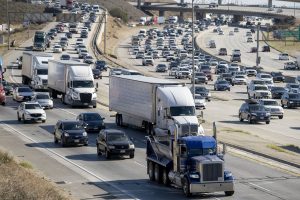This article originally appeared on Inside Climate News, a nonprofit, non-partisan news organization that covers climate, energy, and the environment. Sign up for their newsletter here.
When President Donald Trump signed legislation to revoke California’s authority to enforce stricter tailpipe emissions standards and to ban sales of gas-powered cars by 2035, the effects rippled far beyond the Golden State.
Seventeen states relied on California’s Clean Air Act waivers to adopt stronger vehicle pollution rules on their own, including New York, New Jersey, Oregon, Massachusetts, and Washington.
California, joined by several states, immediately sought a court injunction, calling the revocation illegal on the basis that the waivers are not subject to congressional review and that it violated decades of legal precedent and procedure. These same states recently launched an Affordable Clean Cars Coalition to coordinate legal action and policy to defend their rights to transition to cleaner vehicles.
As the legal battle plays out, states that have relied on the waivers are leaning into expanding multimillion-dollar ways to keep their EV transitions on track. Among their efforts: amping up rebates, tightening rules on the carbon intensity of fuels, and cracking down on pollution where trucks congregate.
“Climate change is still around, whether we have the waiver or not. So we have to figure out ways to make sure that we’re doing what we can to address the problem at hand,” said Michelle Miano, who heads the New Mexico environment protection division of the Environment Department.
According to data from the California Air Resources Board, the states that have passed tougher pollution rules account for about 40 percent of new light-duty vehicle registrations and 25 percent of new heavy-duty vehicle registrations in the United States, where the transportation sector is the highest source of greenhouse gas emissions as of 2022.
Among these stronger rules are the Advanced Clean Cars (ACC) I and II and Advanced Clean Trucks (ACT), which require automakers to sell a growing share of electric passenger cars and medium and heavy-duty trucks to reduce emissions from gasoline-powered counterparts.
The goal is for all new vehicles sold to be electric by 2035.



 Loading comments...
Loading comments...
